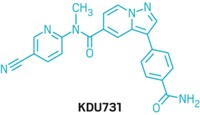Advertisement
Grab your lab coat. Let's get started
Welcome!
Welcome!
Create an account below to get 6 C&EN articles per month, receive newsletters and more - all free.
It seems this is your first time logging in online. Please enter the following information to continue.
As an ACS member you automatically get access to this site. All we need is few more details to create your reading experience.
Not you? Sign in with a different account.
Not you? Sign in with a different account.
ERROR 1
ERROR 1
ERROR 2
ERROR 2
ERROR 2
ERROR 2
ERROR 2
Password and Confirm password must match.
If you have an ACS member number, please enter it here so we can link this account to your membership. (optional)
ERROR 2
ACS values your privacy. By submitting your information, you are gaining access to C&EN and subscribing to our weekly newsletter. We use the information you provide to make your reading experience better, and we will never sell your data to third party members.
Business
Global Health R&D Fund Launched
Public Health: Investment money will advance treatment trials
by Lisa M. Jarvis
September 27, 2013
| A version of this story appeared in
Volume 91, Issue 39

Excitement over new drugs that could address global health problems such as tuberculosis and malaria is often tempered by the reality that much money is needed to finish testing them and get them to market. To address that shortfall, JPMorgan Chase, the Bill & Melinda Gates Foundation, and several corporate and nonprofit partners last week unveiled the first global health R&D investment fund.
With $94 million in initial investments, the Global Health Investment Fund, or GHIF, will back late-stage drugs, vaccines, and diagnostics that could save lives in developing countries while turning a modest profit in the developed world.
“Most people who are active in this space recognize that we’re at a bit of an inflection point in global development,” Peter Scher, global head of corporate responsibility at JPMorgan, told reporters last week. The generosity of deep-pocketed funders like the Gates Foundation has enabled the global health product pipeline, once anemic, to grow to some 200 products. But philanthropy can only go so far, and with government money scarce, firms and nonprofits struggle to fund the final development and commercialization of drugs for neglected diseases.
“There’s just not enough funding in the world to advance those late-stage products to the point where they can get to the hands of the poor,” said Julie Sunderland, the Gates Foundation’s director of program-related investments.
GHIF will offer investors a return by supporting products with utility in both poor and rich countries. For example, a vaccine that could save lives in the developing world might find commercial use in the developed world among the military, travelers, and aid workers.
The fund’s expected annual rate of return of 5–7% is more modest than a traditional biotech fund’s return, but so is the risk: The Gates Foundation and the Swedish International Development Cooperation Agency have agreed to protect up to 60% of the fund’s losses.
Veterans of the neglected disease world welcome the fund but say other creative solutions for late-stage product development are needed. “I certainly applaud the fact that the fund exists,” Mel Spigelman, CEO of Global Alliance for TB Drug Development, told C&EN. “I think it’s probably more conducive to certain diseases and situations than others.”
Indeed, not all projects will be suitable for GHIF, its backers concede. “A big TB trial or big malaria trial is probably too big,” said GlaxoSmithKline’s head of R&D, Moncef Slaoui, who will serve as a scientific adviser to the fund. But GHIF could help plenty of useful treatments that otherwise would not get developed, he added, pointing to a diagnostic test that could predict susceptibility to a particular malaria drug.
Meanwhile, the fund offers a stringent way of vetting projects, Slaoui said. “The bar is higher,” he noted. “There will be milestones and more accountability—and those are drivers of higher performance and quality.”



Join the conversation
Contact the reporter
Submit a Letter to the Editor for publication
Engage with us on Twitter